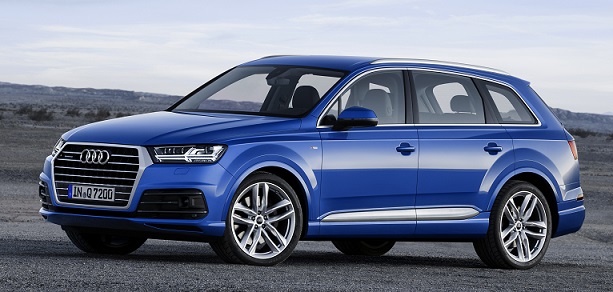

SUV, 5 Doors, 5 Seats
12.7 l/100 km 18.52 US mpg
17.5 l/100 km 13.44 US mpg
9.9 l/100 km 23.76 US mpg
350 Hp @ 6800 rpm.
84.1 Hp/l
248 km/h 154.1 mph
4163 cm3
254.04 cu. in.
8, V-engine
All wheel drive (4x4),
5089 mm
200.35 in.
1983 mm
78.07 in.
2270 kg
5004.49 lbs.
| Brand | Audi |
|---|---|
| Model | Q7 (SUV) |
| Version | Q7 (Typ 4L, facelift 2009) |
| Engine version | 4.2 FSI V8 (350 Hp) quattro Tiptronic |
| Year production start | 2009 |
| Year production end | 2010 |
| Vehicle type | SUV |
| Horsepower RPM | 350 Hp @ 6800 rpm. |
| Acceleration 0 - 100 kmh sec | 7.4 sec |
| Curb weight kg -lbs total |
2270 kg5004.49 lbs. |
| Overall length mm - inch |
5089 mm200.35 in. |
| Doors | 5 |
| Top Speed | 248 km/h 154.1 mph |
| Designation model | BAR |
|---|---|
| Cam configuration | DOHC |
| Engine position and orientation | Front, Longitudinal |
| Cylinders | 8 |
| Position of cylinders | V-engine |
| Displacement (liters) |
4163 cm3254.04 cu. in. |
| Eng. horsepower RPM | 350 Hp @ 6800 rpm. |
| Horsepower per litre | 84.1 Hp/l |
| Weight / horsepower kg/hp - hp/tons |
6.5 kg/Hp154.2 Hp/tonne |
| Weight / torque kg/Nm - Nm/tons | 5.2 kg/Nm, 193.8 Nm/tonne
5.2 kg/Nm193.8 Nm/tonne |
| Torque Nm RPM lb-ft RPM |
440 Nm @ 3500 rpm.324.53 lb.-ft. @ 3500 rpm. |
| Bore (mm in) |
84.5 mm3.33 in. |
| Stroke (mm in) |
92.8 mm3.65 in. |
| Compression ratio | 12.5 |
| Fuel delivery system | Direct injection |
| Fuel type | Petrol (Gasoline) |
| Valvetrain | 4 |
| Engine aspiration | Naturally aspirated engine |
| Engine oil liters | quarts |
9.1 l9.62 US qt | 8.01 UK qt |
| Emission certification | Euro 4 |
| Powertrain architecture | Internal Combustion engine |
| Engine location | Front, Longitudinal |
| Drive configuration | All wheel drive (4x4) |
|---|
| Front brakes | Ventilated discs |
|---|---|
| Rear brakes | Ventilated discs |
| Brake control | Ventilated discs |
| Anti-lock brake system | ABS (Anti-lock braking system) |
| Steering type | Steering rack and pinion |
|---|---|
| Turning diameter m - ft |
12 m39.37 ft. |
| Front suspension | Independent multi-link |
|---|---|
| Rear suspension | Double wishbone |
| Wheels size | 255/55 R18 |
|---|---|
| Wheels rims | 18 |
| Passengers seats | 5 |
|---|---|
| Trunk space min liter | cu. Ft. |
775 l27.37 cu. ft. |
| Trunk space max liter | cu. Ft. |
2035 l71.87 cu. ft. |
| Roof load load kg lbs |
100 kg220.46 lbs. |
| Overall length mm - inch |
5089 mm200.35 in. |
|---|---|
| Overall width mm -inch |
1983 mm78.07 in. |
| Overall height mm -inch |
1737 mm68.39 in. |
| Wheelbase mm - inch |
3002 mm118.19 in. |
| Track width front mm - inch |
1651 mm65 in. |
| Track width rear mm - inch |
1681 mm66.18 in. |
| Coefficient of drag | 0.37 |
| Curb weight kg -lbs total |
2270 kg5004.49 lbs. |
|---|---|
| Gross weight kg -lbs total |
3095 kg6823.31 lbs. |
| Capacities kg - lbs |
825 kg1818.81 lbs. |
| Fuel tank liters | gallons |
100 l26.42 US gal | 22 UK gal |
| City l/100km - mpg |
17.5 l/100 km13.44 US mpg |
|---|---|
| Highway l/100 km - mpg |
9.9 l/100 km23.76 US mpg |
| Combined l/100 km - Mpg |
12.7 l/100 km18.52 US mpg |
| Autonomy km (combined use) | 833 |
8 CYLINDER V-Engine
https://www.thecarspec.net/components/engine/8-cylinders-v